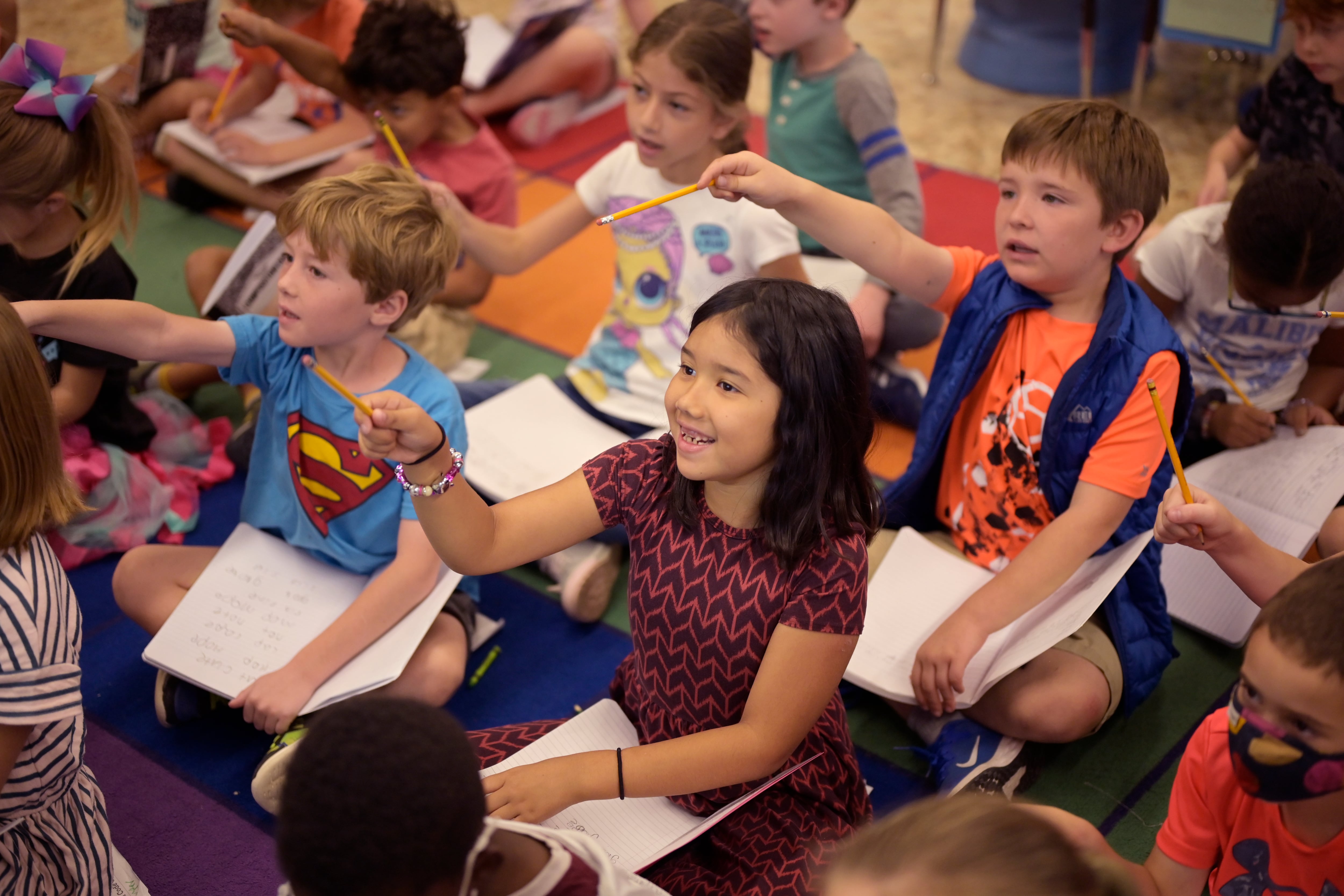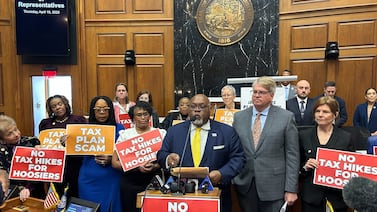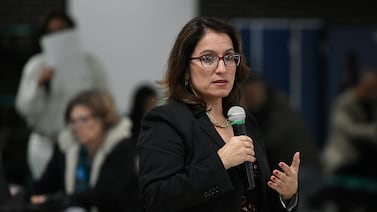A roomful of second graders spent a recent fall morning learning about a bossy mother named “Mama E” who follows her kids around reminding them to say their names.
The whimsical story was part of a phonics lesson at Denver’s Bradley International School. The point was that adding an “e” at the end of a word changes the first vowel from short to long — for example, pin becomes pine because the “i” says its name.
Teacher Megan Bobroske challenged the children sitting elbow to elbow on a rainbow striped rug in front of her — could Mama E live at the front of the word instead of the back? A little boy named Peter piped up: “She has to be at the end of the word.” he said. “Imagine if she’s on the front of the line, she’s going to be too busy saying her name.”
Peter and his classmates were learning a rule about the English language that they applied over and over that day — when reading and writing “hope,” “cute,” “tape,” and “slide.” Such lessons reflect both a districtwide and statewide shift in how children are taught to read in Colorado.
Gone by the wayside are reading programs that encourage children to figure out what a jumble of letters says by looking at the picture or using other clues to guess the word — a debunked strategy still used in some popular reading curriculums. Now, there’s a greater emphasis on teaching the relationships between sounds and letters in a direct and carefully sequenced way. It’s part of the science of reading, a large body of knowledge about how children learn to read.
Some teachers are pleased with the new reading curriculums rolling out at their schools, but there are bumps, too — confusing technology, new ways of grouping students, or an overwhelming amount of material, to name a few.
The hope is that better curriculum materials combined with a recent statewide teacher training effort will transform reading instruction — and boost reading achievement — across Colorado.
“Those are definitely the biggies,” said Floyd Cobb, associate commissioner for student learning at the Colorado Department of Education.
But is it enough to propel a statewide reading turnaround? And if so, when?
Cobb said the timeline isn’t clear — in part because curriculum shifts are still underway in some districts and because the most immediate results will show up in routine K-3 reading assessments given by school districts rather than state tests given at the end of third grade. Scores from those routine assessments aren’t posted publicly in a central location like state test results are.
This year, about 41% of Colorado third graders scored at or above grade level on state literacy tests, which combines reading and writing. While that proportion matches 2019 levels — a piece of good news after pandemic-era declines — it still means that tens of thousands of children are struggling with basic literacy skills.
Krista Spurgin, executive director of Stand for Children Colorado, said she believes the state’s curriculum and teacher training initiatives have changed the mindset about how reading should be taught in Colorado.
“I’m really hopeful that in a couple years, we’ll start to see outcomes for third graders,” she said.
Big districts make the switch
Colorado’s largest school districts, including Denver, Jeffco, Douglas County, Cherry Creek, and Aurora, are among those phasing in new reading curriculum. A major state reading law passed in 2019 prompted the shift by requiring schools to use scientifically based reading programs in kindergarten through third grade.
Previously, Colorado schools were allowed to pick any reading program or none at all. Now, there are tighter guardrails in place — though districts can still pick from more than a dozen core programs. A year ago, state officials began enforcing the stricter curriculum rules, ordering a host of districts to replace unacceptable programs.
The move was unprecedented and some districts initially pushed back, arguing that they layered in state-approved programs with state-rejected ones. State officials didn’t relent.
The second grade teachers at Bradley International knew something needed to change in early 2021, even before state oversight came into play. Their reading program at the time had big holes when it came to phonics. Often, if students got stuck, they were told to “look at picture clues and guess what would make sense or even just skip the word,” Bobroske said.
Lessons didn’t clearly state — and consistently review — how letters and sounds work together. She said, for example, that students might have learned part of the “Mama E’’ rule, without understanding that a consonant sound must occur between the vowel and the “e” at the end of the word. That omission would lead students to misapply the rule and get frustrated when words didn’t make sense.
“Students did not have the tools to actually break down the words and there was a lot of guessing and hoping for the best,” she said.
Bradley’s second grade team began using the phonics portion of a new reading curriculum — Core Knowledge Language Arts — and saw impressive results. The following year, when the school piloted the whole program in some grades, Bobroske’s students made 1½ years worth of reading growth.
“It was crazy,” she said. “In all honesty, I’ve never seen anything like that happen before.”
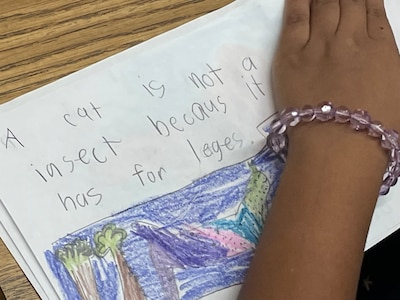
Besides a stronger focus on phonics, new reading programs in Denver and some other districts include science and social studies-themed units meant to build students’ background knowledge about the world — an approach that helps students understand what they’re reading.
Molly Veliz, a Denver teacher who works with struggling readers at Marie L. Greenwood Early-8 school, said the knowledge-building units of Core Knowledge Language Arts have grabbed students’ attention.
“First graders can tell me every body system and how they work together and [they’re] using appropriate vocabulary,” she said.
Strengths and weaknesses
Ibeth Leon Ariza teaches at a dual language immersion school in western Colorado where all elementary students get both English and Spanish instruction. She said the old reading program included Spanish passages that were inauthentic translations and didn’t capture the meaning conveyed in the English version. Leon Ariza, a native Spanish speaker from Colombia, tried to fix such shortcomings by substituting more appropriate vocabulary or modifying the stories.
She doesn’t have to do that now. The district’s new state-approved curriculum, Into Reading and its Spanish counterpart ¡Arriba La Lectura!, has better Spanish materials.
About half of all Colorado students identified as far below grade level in reading are also English learners, raising questions about whether schools are detecting weak reading skills or limited English proficiency, and whether students have access to appropriate instruction. A recent state audit of Colorado’s reading efforts flagged both issues and recommended changes.
While Leon Ariza generally likes her district’s new reading program, which rolled out last year, there are weaknesses too. She finds the online platform hard to navigate and said teachers can’t fit everything the lessons suggest into the daily reading block.
“We are still having struggles with time,” she said.
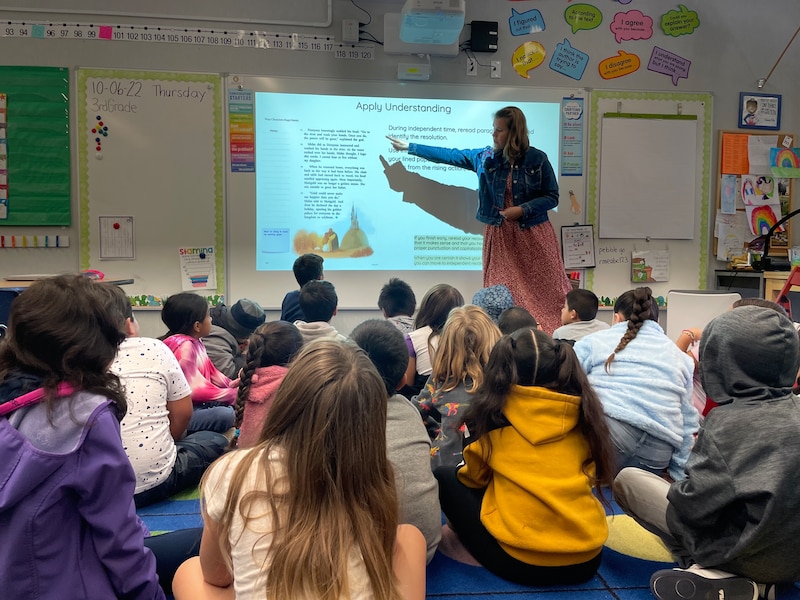
Along with the inevitable learning curve that comes with new curriculum, many Colorado schools continue to face a host of challenges that impact student learning, including staff turnover, residual COVID disruption, and family stress. Rocky Mountain Elementary in the Adams 12 district north of Denver is one of them.
“The historical story of our school is that it had been chronically underperforming for almost a decade. I’m their fourth principal in 10 years,” said Principal Kate Vogel, who took the reins during the pandemic.
Last spring, nearly 40% of the school’s kindergarten through third grade students were significantly behind in reading. In addition, about half the school students are English learners and nearly 90% qualify for subsidized meals, a measure of poverty.
On a recent morning in Megan Neitzel’s classroom, third graders worked on writing a summary of “The Tale of King Midas,” which was one of the stories in their new curriculum, Benchmark Advance 2022. For some students, it was easy. One girl blazed through her retelling of the Greek myth to a visitor, correctly noting which part was the climax of the story and explaining the king’s bad choice. (He turned his daughter to gold.)
Meanwhile, other children struggled. In a small group gathered at a table around Neitzel, one boy asked “What’s a setting?” He also struggled to spell “castle.”
“Sound it out,” she said. “What do you hear?”
When the boy mumbled a non-response, she prompted him through it.
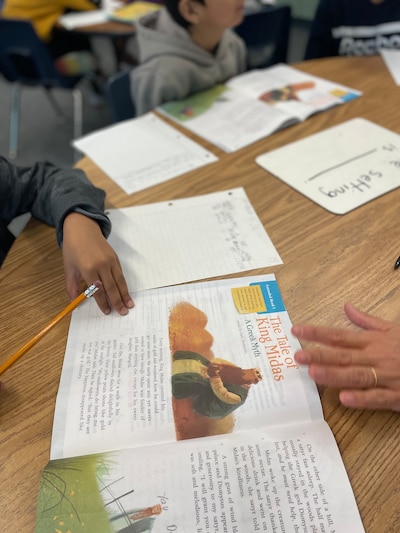
Neitzel likes the new curriculum so far — the way phonics and vocabulary are taught and because her students are excited about reading. Some bring their full-color workbooks home to read passages to younger brothers and sisters, she said.
Vogel believes the new curriculum, along with state-mandated reading training, and recent district efforts to dig deeply into reading standards have made a difference.
“I just think teachers have a much better understanding now that … we’re focused on the science of reading,” she said.
Checking the to-do list
Some of Colorado’s biggest reading improvement efforts have been underway for just a few years, but evidence from inside and outside the state suggests they could eventually make a difference.
One promising case study comes out of Mississippi, where state officials launched a slew of reading initiatives starting a decade ago, including teacher training on the science of reading.
In 2013, the state was at the back of the pack for fourth grade reading achievement on a test called the National Assessment of Educational Progress. By 2019, Mississippi ranked first in the country for reading gains, with its fourth graders matching the national average for the first time.
Within Colorado, a literacy grant program begun in 2012 produced impressive literacy gains at many participating schools. The three-year awards were given to schools that agreed to overhaul reading instruction, using the same kinds of levers — strict curriculum rules and guidance for educators — that are now kicking in statewide.
But the gains often faded after the grants ran out, sometimes because of staff or principal turnover. Program leaders also said some teachers didn’t have the grounding in the science of reading that they needed to sustain the coaching and other help they received through the grant.
But things are different today.
The vast majority of Colorado’s K-3 teachers have completed state-mandated training on reading instruction. Several prominent teacher preparation programs have revamped their reading coursework. And prospective elementary teachers must now pass a separate exam on reading instruction to earn their state licenses.
The state has more on its reading to-do list, including additional reviews of teacher prep program reading coursework and the rollout of a new state-mandated training for elementary principals and teachers who work with struggling readers in fourth through 12th grade.
Spurgin, of Stand for Children, also believes the addition of tuition-free full-day kindergarten in 2019-20 and the launch of tuition-free preschool for Colorado 4-year-olds next fall will help boost students’ reading skills.
For now, she’s optimistic about changes unfolding in Colorado classrooms.
“We have talked to teachers who are already seeing improvements in their classrooms, which just feels really energizing,” she said.
Ann Schimke is a senior reporter at Chalkbeat, covering early childhood issues and early literacy. Contact Ann at aschimke@chalkbeat.org.

